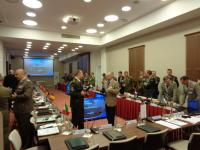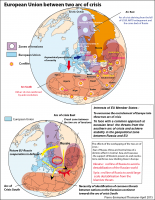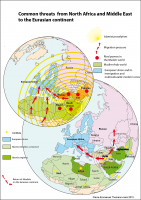Summary report of the FINABEL Conference
COS PME II-2015 Meeting
Trencin, Slovakia, 21 april 2015
Dr Pierre-Emmanuel Thomann, IERI, Brussels

The Finabel Coordination Committee is a Land Forces organisation comprised of 17 Member States of the European Union to promote interoperability between its Members.
The annual conference of the chief of staff Committee (COS) and the Principal Military expert Committee (PME) took place in Trencin, Slovakia the 21st of April. A conference on the future of Land forces has been organized on this occasion. The IERI has been invited to contribute to this conference and this paper presents a summary of the two following contributions:
- Lieutenant General (LTG) Michel Yakovleff - SHAPE- NATO made the keynote speech
- Dr Pierre-Emmanuel Thomann - IERI, made a presentation on « European Union squeezed between two arcs of tensions »
THE ARMY CHIEFS OF STAFF COMMITTEE (COS)
Executive, the highest level. It meets once a year to summarise work of the past year and to establish the objectives for the coming year. The Chairmanship of the COS Committee changes annually.
THE PRINCIPAL MILITARY EXPERTS (PME) COMMITTEE
Made up primarily of officers responsible for doctrine, planning and studies within the staff of land components of Finabel member states. This Committee analyses the directives of the Chiefs of Staff and reformulates them in terms of missions. Belgium provides the Chairman for this Committee.
High level Conference : The future of European Land forces
Introduction
The existence of armies is a permanent fact as all countries have their own armies or someone else's army.
War in the future is a real prospect.
We experienced more than two decades of intoxication about the soft power replacing definitely the hard power. However, still today, hard power is the ultimate tool, tanks and land power count in the end in a conflict and determine the issue of the conflict (for example, in Somalia, the training of the Somalian army on the ground made the difference more than maritime operations to eradicate piracy).
The change of paradigm: from « luxury wars » to contested battlefields
So far, since the end of the Cold War, the Western world experienced « luxury wars » where land forces could operate in an environment where its armies could achieve total air superiority, maritime superiority, electro-magnetic superiority and finally land superiority because it entered in conflicts with weak opponents.
We are facing a paradigm change: for the Western armies it was too easy and they had « luxury wars » because air power was not contested. Evacuation of wounded soldiers for example was made within an hour; this was the golden hour (although this is not the case for French forces in Africa, in Sahel). In the future, land forces will have to operate in combat fields with contested land, contested air, contested sea, and contested electromagnetic space.
During the Second World War, there were about 20 German submarines operating in the Atlantic at the same time. During the cold war, USSR forces could gather 64 submarines for an exercise. We can expect a contested sea in future conflicts.
In the future, logistics could also in a much easier way be degraded by potential enemies. GPS for example can be very easily degraded because it is easy to jam. The land forces depend more and more on technology, like artillery for example and will be vulnerable if electromagnetic space is contested.
Culture of command and operational culture
The culture of command and operational culture in NATO is too rigid.
The top down command culture does not give enough margin of manoeuvre to officers on the battlefield at lieutenant/captain level and platoons on the battlefield.
The future of land armies could be very different from today: in 20 years, robots will be integrated parts of a platoon and drones will fly around in a city for example, both in the air and underground. The problem with this trend is the impact on populations.
War is in the end a psychological event, where armies try to impress the populations to agree to their own definition of peace. The soldiers look more like ugly extraterrestrials and this will have an impact on populations and reinforce resistance. We also reached the limits of what a soldier can carry in terms of equipment and we can imagine there will be robots carrying the armour on a robot donkey (similar to Roman time’s soldiers). However we have to admit that soldiers will be killed in situations where they won’t have their armour since they cannot wear it all the time.
The army model that has been sold the last decades is the small expeditionary model, in fact an Anglo-Saxon model with professional and competent armies.
However, in the future, we can have again conscript armies as they can also be very professional (like the Swiss army). In Ukraine, they combined the disadvantage of having a fading conscript army without yet a new competent professional army.
In the future there might be again frontlines (this is not the official line of NATO exercising for expeditionary army) and the air, land and electromagnetic space will be contested.
In NATO, the routine exercises should be broken as military personnel is trained to the same situations, in particular the doctrine of air superiority. The need to have air superiority to engage land forces should not be a precondition anymore in some situations because total air superiority won’t be any more possible in the future. It will be useful also to train without electromagnetic superiority and to adapt to new forms of cyber war (for example a campaign of disinformation on a high rank officer accusing him of being a paedophile to disrupt the command line and break the moral of the troops). Officers have to be trained to operate in a more autonomous behaviour.
Conclusion
In conclusion, the West may face real enemy in the future (next 20 years) and break the routine of « luxury wars ». War is back and it will be difficult to convince European population that muscle must be rebuilt, but also the right muscle.
The land forces must also be more playful and avoid repetitive actions and be able to make the adversary make mistakes (like the Russians are good at that and we should study that) ; officers should also know better the other regiments way of fighting as more cohesion and degree of operating together will be required. The officers should be more innovative, like rebels on a war field (but we cannot promote rebels).
Dr Pierre-Emmanuel Thomann
Directory of research in geopolitics, IERI
Founder of www.eurocontinent.eu
pierre-emmanuel.thomann@eurocontinent.eu
Intervention: « European Union squeezed between two arcs of tensions »
The utility of geopolitical analysis
It is necessary to establish a diagnosis on security threats and risks to European Union territory and populations before to think about military capabilities (the reverse approach is currently put into practice and distorting a right diagnosis of the situation). A central point is then to examine the different/common perceptions of security between European Union Member States according to their history/geography. The security perception has an impact on geopolitical priorities and they diverge between EU Member States (mainly Southern orientation of France and Eastern orientation of Germany). The posture of third powers must also be understood to know their red lines in order to avoid mistakes and unnecessary suspicion that spiral into conflict when taking wrong decisions.
Lessons from past mistakes and success stories should also be central to adjust security and defence policies. As an example, we should remember about the incoherence between the decisions taken during ex-Yugoslavia crises and its impact on the Ukrainian crisis today as the territorial integrity of Ukraine is today Western priority, but not for Yugoslavia in the 90’s. Some aspects of the operations in Afghanistan, Iraq and Libya war can be considered as military successes but they are political failures. The situation of these countries and our security is worse today than before these military operations. The operations in Mali, Central Africa were initiated for example partly to repair the mistakes of the previous destabilization of Libya.
Finally, it is necessary to forge common European priorities on territory. Negotiations would be long and difficult but it may have been more useful to engage ourselves in that direction than applying a restrictive legal and economic approach during ten years of negotiations for the Lisbon Treaty with few results: there is still no real European common diplomacy and no credible common European and defence security policy.
Geopolitical diagnosis
The world is experiencing an evolution towards a multipolar world and an enlargement of factors of power (the combination of different factors of power during a conflict is named as a « hybrid war »). Globalization can be defined as a fight to carve up geopolitical spaces between the different state powers but also sub state actors.
In this new world, we are confronted to permanent instability and uncertainty coming from State rivalries mixing territorial rivalries on the ground, air space, maritime space and cyberspace. It is then more and more complicated to make a right diagnosis of a geopolitical situation and to build a coherent strategy.
Geography and History are the main factors to understand a crisis. In the case of Ukraine, old historical maps are necessary to understand the geopolitical stakes between the actors.
The importance of ground forces remain central since control of territory is the most important objective in most of the past and future crises (the German philosopher Carl Schmitt said that human beings are not fish nor birds but have their feet on the ground, so what is happening on the ground is what is the most important). Because of technological breakthroughs, we can fly, navigate and enter cyber space, but in the end, we live on the ground and the need to control ground territory remains the main geopolitical stake.
There is an illusion of total control of territory from air, cyber space or maritime zones. The current « technique supremacy » ideology to master our geostrategic spaces is misleading.
Threats and risks to Europe
The land forces of European Union Member States face today many different scenarios. Hybrid wars are not new: the Chinese strategist Sun Tzu invented already the concept.
We are also experiencing an evolution from defence to global and home security missions when classical threats are still credible scenarios. European taboos in some countries make it difficult for the army to operate on home territory.
When we examine the geopolitical situation map of Europe and its geographical surroundings, the Southern arc of crisis is the source of Jihadist forces threats, failed States and hostile States. This area is potentially the source of the worst security scenario for European territory. (See map « European Union between two arcs of crisis »)
Hybrid war originating from the Southern arc of crisis is the most likely threat. The scenario combining internal threats (uprising of European cities suburbs concentrated with non assimilated minorities) mixed with home grown jihadist terrorist acts and manipulation and support from hostile third States from the Southern arc of crisis is a situation we have to anticipate (See map « Common threats from North Africa and Middle East to the Eurasian continent »).
The Eastern arc of crisis presents many risks but constitutes no threats as there is no enemy in this area. Most likely is the destabilization of this area because of civil wars provoking flows of refugees. A nuclear power plant incident can also be a risk for European Union Member States. However, the degree of potential escalation depends also on the attitude of European States and their own political decisions.
Utility and optimization of land forces: main features
- Special forces sent to remote and difficult locations (Sahel)
- Urban combat abroad (Sahel) and on home territory in Europe
- Interventions in support of civilian powers for security risks (nuclear power plant)
- Less likely scenario : worst case scenario of full scale intervention (example : blockade of strategic maritime passage)
- Since budgets are squeezed, then ability to rebuild forces for a classical conflict if necessary is required
- Think the unthinkable and adopt European hybrid strategy
Conclusion
The Eurasian continent faces common threats from the Southern arc of crisis with the destabilizing actions of jihadist forces (see map « Common threats from North Africa and Middle East to the Eurasian continent »). The European Union Member States are increasingly squeezed between these two arcs of crisis on the South and East and it is in our security interest to overcome this situation of encirclement.
However, we lose time with the Ukraine crisis. The threat of escalation in this area depends also on the actions from European States, and red lines from our neighbours shouldn’t be crossed (like in Ukraine crisis, there is a lack of geopolitical analysis at EU level). Since Russia is not an enemy for European security in the Eastern arc of crisis (it is not in the interest of EU Members States to have more fragmented geopolitical space on the Eastern flank), the Eurasian nations, EU Member States, Eastern European states, Russia, Central Asian States, and also possibly China should cooperate more to face these common threats coming from the Southern arc of crisis (See map « European Union between two arc of crisis »). Increasing military cooperation was initiated between EU and Russia in EU operations in Africa (transport with helicopters) before the Ukraine crisis and there should be a reset in that direction.



